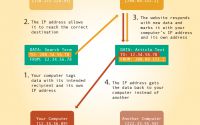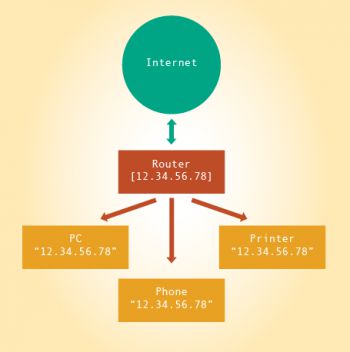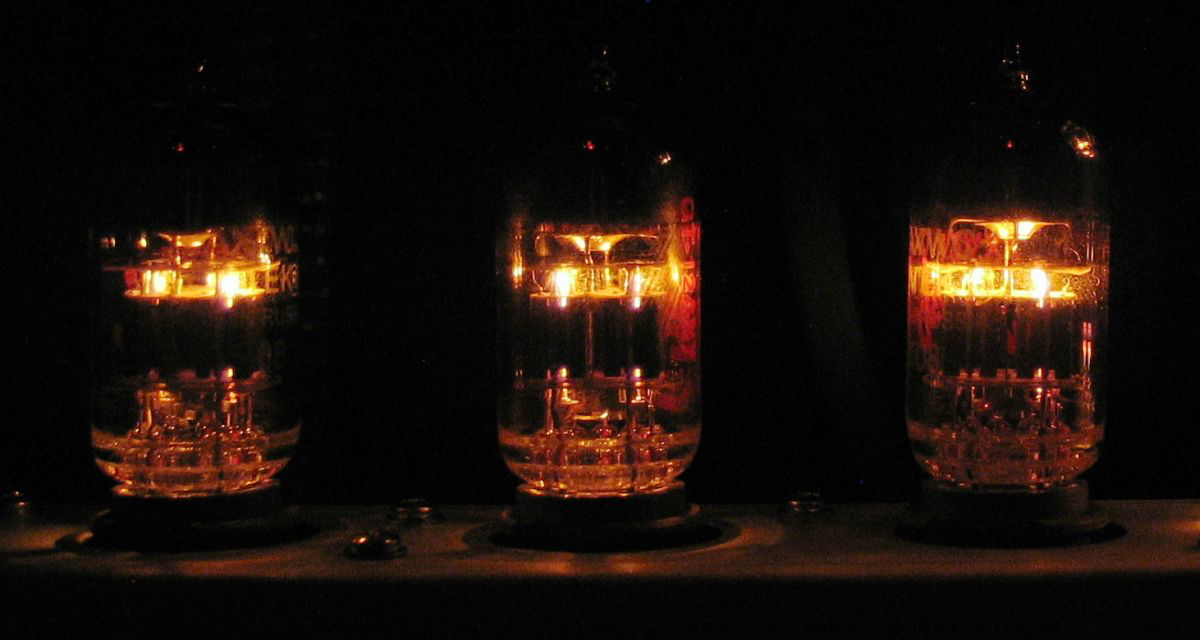Internet Protocol (IP) addresses form the foundation of the internet. Every device and website requires an IP address to send and receive information. Unfortunately, IPv4, the current IP address system, is limited to approximately 4 billion possible addresses, a threshold that is quickly approaching as countless new devices connect to the internet. When no IPv4 addresses are left, new devices and websites will be unable to access the internet. Temporary solutions such as IP address sharing in business and home networks have helped slow the depletion of IPv4 addresses, but the only true solution to this problem is the full implementation of IPv6, a new protocol that allows for an essentially limitless pool of unique addresses. The transition between these two incompatible systems has been slowed due to costs and lack of incentive, but now that IPv4 addresses are truly running out, the internet community at large is moving to complete the transition within the next decade. If all goes as planned, individual users will not notice any change; IPv6 will simply expand the internet to continue to provide access to more people around the world.
Is the Internet Full?
From entertainment to business, the internet is an undeniably fundamental part of society. Internet access connects the world, driving economies and spreading knowledge. Because the internet enables freedom of expression and promotes societal progress, the United Nations declared internet access a human right in May 2011 [1]. After growing without bound in the last two decades, it is hard to imagine any limits on the internet’s size. This perception, however, could be shattered as the internet may soon be forced to close its doors to new websites and devices.
In order to send or receive any data on the internet, each device or website needs a unique Internet Protocol (IP) address to identify itself, and the pool of IP addresses is rapidly depleting. As advances in technology enable millions of devices to connect to the internet in new and sophisticated ways, these devices may actually be unable to connect simply because they lack an IP address. Perhaps more detrimentally, developing third world businesses could be cut off from the internet access required for competition in the global economy. Thankfully, engineers are aware of this impending issue and are rapidly preparing solutions. As the world continues to develop, however, IP address depletion still poses a global problem.
IP Addresses Demystified
Before explaining IP address depletion, it is important to understand how IP addresses work and what purpose they serve. It may be simplest to think of IP addresses as phone numbers for the internet. Just as your phone has a unique code that allows others to contact you out of a sea of billions, each internet-capable device or website has a unique IP address to direct data to the correct location in the nearly infinite reaches of the internet. When you send data from your computer to a website, it is marked with the IP address of the target site so your computer knows where the data should go. In addition, your computer tags the data you send with your IP address so the website may respond properly. This system is represented in the Figure below (Fig. 1).
IP addresses are not usually visible to the average user and are hidden by a system of domain names such as “illumin.usc.edu,” which acts as a interface for internet users. When you enter a website’s domain name, your computer automatically looks up and uses the proper IP address to access the website. It is possible to bypass domain names and navigate by IP addresses alone: simply type http://128.125.124.93/ into your browser to see an IP address in action.
IP addresses themselves are not complicated. Like a phone number, they are simply a sequence of digits. Unlike phone numbers, however, IP addresses contain only ones and zeroes, and are 32 digits, or bits, in length. These 32 bits form four groups of eight, each known as a byte. A byte of data, when translated from binary, can represent a value between 0 and 255 (Fig. 2).
[image=803 file=”IPAddress_2-175×176.jpg” placement=”left”]Fig. 2: IP address representations. The 32-bit address is translated into traditional numbers byte by byte. To simplify internet navigation, each website is assigned a domain name, which is matched with the proper IP address on a registry. [/image]
Internet Protocol Versions
IP addresses are just one aspect of the overall internet protocol, which also contains regulations for security and technical details. The current internet protocol is version 4 (IPv4). Versions 1 through 3 were merely drafts that never gained widespread use, and version 5 exists as an experiment and will not be implemented [2]. Created in 1983, during the early phases of the internet, IPv4 allows over 4 billion unique addresses to be in use [3]. At a time when only a few thousand devices were connected to the internet, and these were only operated by research institutions and the government, 4 billion addresses seemed more than sufficient. Unfortunately, with a global population of over 6 billion, there are not enough IP addresses for every person on Earth in an age when internet access is becoming a vital component of life. This is compounded by the fact that the internet has grown far beyond what pioneers could have imagined, with many individuals using not one, but multiple internet-capable devices such as family computers, personal laptops, gaming consoles, and phones [3]. The lack of new IPv4 addresses could, therefore, effectively shut out new devices or websites, including smart phones, community computers in a developing nation, or small business homepages.
Global IP Address Distribution
The Internet Assigned Numbers Authority (IANA) is a global body that divides IP addresses among regional internet registries (RIRs), as presented below (Fig. 3). RIRs, in turn, coordinate IP addresses in their regions and ensure that no two devices receive the same address by mistake [4]. Each RIR is directly responsible for selling and distributing IP addresses to customers such as Internet Service Providers (ISPs) or governments and large institutions in its geographic area.
In the past, if an RIR had no IP addresses available, it could request more from IANA. However, on February 3rd, 2011, IANA issued the remaining IPv4 addresses, leaving the RIRs to operate on a limited pool of addresses for their regional customers. ARIN, the RIR for North America, has implemented restrictions on the number of addresses it will sell and maintains a countdown on its homepage for the number of remaining North American IPv4 addresses [5]. More alarmingly, the RIR for the Asian-Pacific region exhausted all but a small reserve of its IPv4 addresses by April of 2011, little more than two months after receiving its final allotment from IANA, and can no longer sell new IPv4 addresses to most customers [6]. The remainder of the RIRs are expected to run out of IPv4 addresses by 2013 [7].
Temporary Solutions to Slow Address Depletion
While the supply of IPv4 addresses may only recently have reached a critical low, engineers have been working on this problem for over a decade, and many temporary solutions exist. One of the most common solutions, used in homes and businesses worldwide, is the Net Address Translation (NAT) system. This system essentially allows a router or modem to work as an IP access point for all the devices in a home or office. The router itself is the only device that is assigned a unique IP address, which it uses to communicate with the outside world [8]. Just as an office may have a single phone number, with multiple individual extensions, the router gives each connected device a unique extension and properly directs all data. In this way, every device attached to the router can essentially share a single IP address, as shown below (Fig. 4).
NAT has become incredibly common over the last decade, but it cannot itself solve the problem of IPv4 depletion. NAT creates a vast, complicated, and difficult to manage network under the banner of each IP address, leading to higher maintenance costs and reduced performance [7]. Furthermore, many new applications of the internet, such as video chatting and online multiplayer gaming, require rapid and consistent connections. This is often difficult to achieve between devices hidden behind layers of network codes, many times resulting in stuttering or failed connections [7].
IPv6: A True Solution
Thankfully, the Internet Engineering Task Force (IEFT), a group dedicated to developing and maintaining internet standards, has created what they believe is a permanent solution to IP address depletion. In 1998, IEFT developed a new system of IP addresses, known as IPv6 [7]. IPv6 is similar to IPv4, but essentially replaces the 32 bit IPv4 address with a 128 bit address, which allows for 3.4×1034 (340 undecillion) unique addresses [3]. By simply quadrupling the length of IP addresses, IPv6 creates 667 sextillion addresses for every square meter of Earth’s surface [9]. These quantities are difficult to grasp intuitively, but IPv6 essentially provides an inexhaustible supply of IP addresses.
The primary benefit of IPv6 is that it alleviates the lack of IP addresses. IPv6 renders NAT systems unnecessary and allows the internet to return to its original and intended configuration where every single device has its own dedicated IP address. The greatest issue preventing the complete transition to IPv6, however, is its incompatibility with IPv4. This incompatibility stems from the basic programming of most devices and websites, which cannot process IPv6 addresses or the additional features of IPv6 overall [4]. Technologies exist to translate between IPv4 and IPv6, but these are typically unreliable and inconsistent , and are not seen as viable long-term solutions [2]. Luckily, most consumer electronics have been made both IPv4 and IPv6 compatible for the last decade, as the industry has long been aware of the necessary shift [3]. Chances are that your computer and router are IPv6 capable right now. Unfortunately, some devices, such as DVRs and game consoles, are still incompatible with IPv6 [3]. In order to solve this issue, companies may be required to issue millions of updates or new devices to their customers [4]. In addition to the costs of providing new devices to customers, it will be necessary to run both IPv4 and IPv6 services for a significant period during the transition, and it will cost time and money to train technical staff to work with the new systems [4]. The only incentive for ISPs and content providers to upgrade to IPv6 during the last decade was the urging of the IEFT, but the costs of transitioning outweighed the immediate benefits of IPv6 for many companies [4]. Only since IPv4 addresses have become more difficult to obtain has this attitude finally changed. This shift has led many governments and RIRs to create legal obligations and financial incentives to catalyze the shift [4] [10].
Happy “World IPv6 Day”
Before a transition can occur, ISPs and major web content providers must test for problems the implementation of IPv6 could create for their customers, due to the unpredictable complexity of individual systems. In order to collect data and give IPv6 a true test run, the Internet Society, a nonprofit organization that provides leadership in internet policy, declared World IPv6 day on June 8, 2011. For 24 hours, thousands of websites, including major sites such as Google and Facebook, switched to IPv6 versions globally [11]. If you did not notice IPv6 day, it is most likely because of the success of the experiment. Any customers whose computers were IPv6-capable simply connected to the otherwise identical IPv6 version of the website. Meanwhile, data was collected on customers who did experience problems in order to address those issues before the real transition occurs [11].
A Painless Transition
A complete and sudden shift between the two IP versions would be impossible with the complexity of the internet today, so IPv6 implementation has instead been gradual, and both protocols are expected to coexist for over a decade, with websites providing parallel IPv4 and IPv6 versions in a system known as dual-stacking [4]. Inevitably, IPv6-only websites will begin to appear when the owners of the website cannot register for an IPv4 address. At this point, customers whose technology is not fully IPv6 compatible will begin to have connection issues. These customers may be unable to view these websites at all, or they may have some slow, translated connectivity [2]. Ideally, these issues will be rare.
Beyond maintaining normal hardware and software updates, individual users of the internet need not worry about the IPv4 to IPv6 transition. Despite previously slow IPv6 adoption, the foundations for transition are well established and IPv6 implementation should accelerate with no noticeable change from the individual user’s point of view. IPv6 will simply allow the internet to expand and to continue to provide access to more people around the world. Websites will look no different and will continue to operate as usual. Overall, the transition to IPv6 will be mercifully uneventful as engineers work behind the scenes to liberate the backbone of the internet from its current limitations, allowing for virtually infinite growth into the future.






